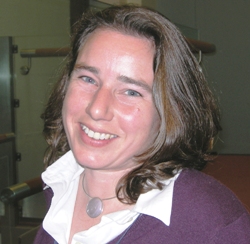
“The future of the geosciences in the 21st Century” was recently made the subject of a joint Geological Society/BGS meeting. Kathryn Goodenough, and her colleagues at the BGS Futures Team, have already been stroking the crystal ball…
Geoscientist 20.4 April 2010
Geoscience can be divided into two broad (and overlapping) strands: curiosity-driven (‘blue skies’) science; and applied science. The first is driven by the big, unanswered scientific questions, while the second is driven by the needs of society. The Natural Environment Research Council (NERC) funds research in both these strands, and in recent years a fair amount of funding has been directed towards the understanding and prediction of climate change. The priorities for Earth science research are bound to change over time: can we predict what these future priorities are likely to be?
One popular tool for looking at future trends is “scenario planning”, in which researchers consider possible futures based on a small number of variable factors. However, as geoscientists we know that there are many other variables. Even with our modern understanding, there is still much we still don’t know about how the Earth System will change in the short-term under the pressures we are placing upon it. So, BGS’s Science Futures team has based its first scenario assessment on two axes: one denoting the rate of change of the Earth System, and the other a political/economic axis described as the amount of global cooperation versus competition.
At one extreme of this axis lies a ‘Global Village’ scenario – a utopian world where all countries work together to reduce emissions, slowing the rate and overall impact of climate change. As standards of living rise, natural resources continue being traded in a free and open market, and new technologies continue to drive the global economy. By cooperation, the world’s special places are protected, so that loss of biodiversity is also slowed. This ideal situation seems, to us, rather unlikely.
At the other end of the spectrum, governments do not cooperate fully on emissions reduction, and national protectionism leads to insecurity and instability. Britain becomes a ‘fortress’, fiercely protecting its coal, water and renewable energy sources. Large numbers of people move away from areas affected by flooding, drought and rising sea level. This may be what we all want to avoid, but every time that targets are not met and agreements fail, we potentially move one step closer. You can find more information about these and intermediate scenarios at
www.bgs.ac.uk/sciencefutures. We would greatly appreciate your views on which you feel is most likely.
Some conclusions can be drawn now. At the moment it seems vital to quantify the Earth System’s rate of change. However, sooner or later, we may well reach a “tipping point” – some would say we have already reached it – from which the System will be unable to return to what most people think of as the status quo ante. From then on, the rate of change becomes moot; what matters then is adaptation and mitigation strategies in a world of rising population, where natural resources (water, productive land, space for waste disposal, energy and minerals) can only ever become more precious.
Geoscientists must be prepared to adapt. Today’s priorities may suddenly look like yesterday’s news.
*on behalf of the BGS Science Futures Team (Jon Chambers, Kathryn Goodenough, Daren Gooddy, John Laxton, Jon Naden, Barry Rawlins, Helen Reeves, David Schofield) BGS Science Futures Team was set up two years ago, to identify the main challenges for BGS scientists over coming decades.